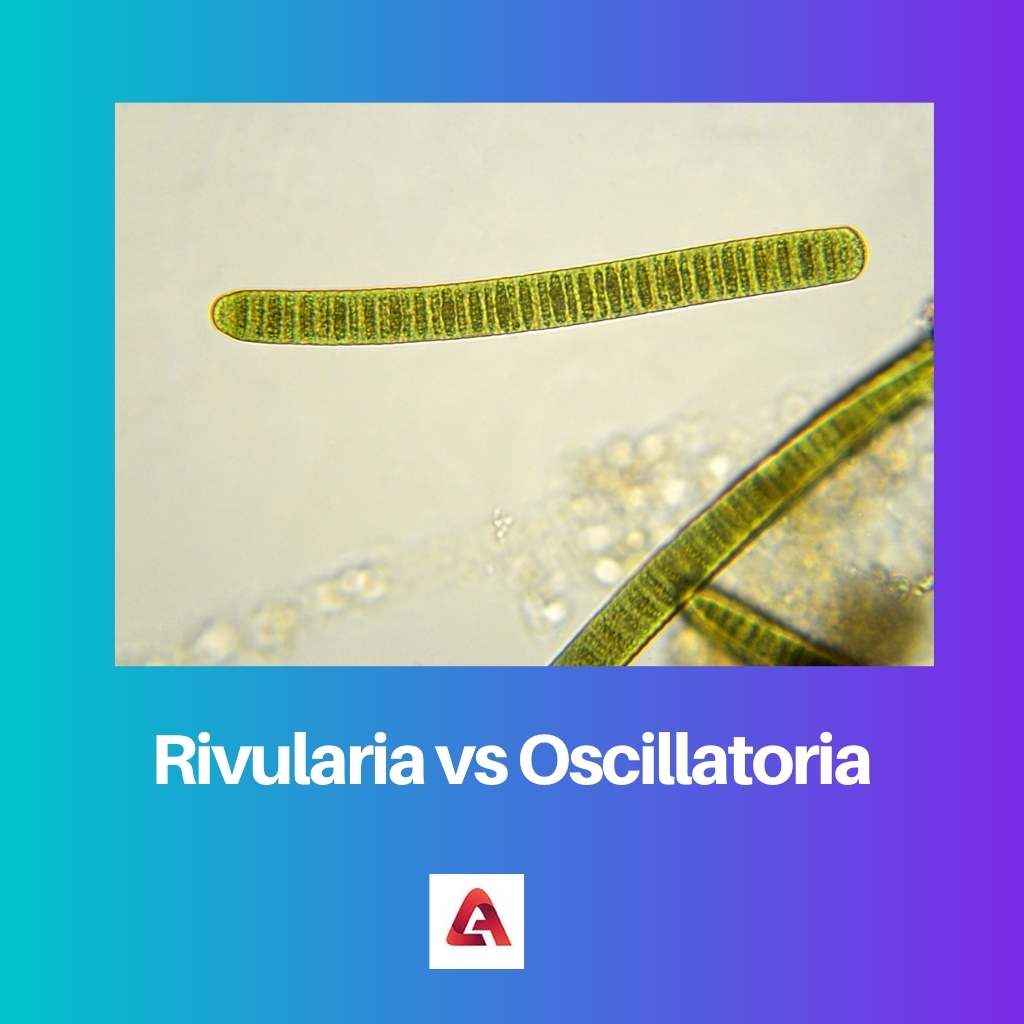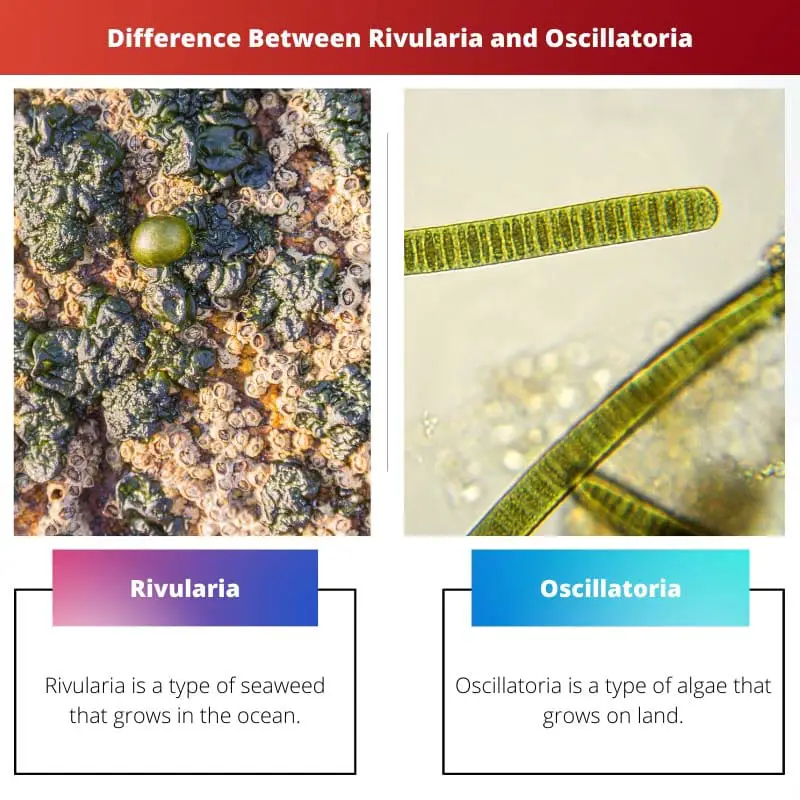Rivularia and Oscillatoria are two types of algae. A similarity is that Rivularia and Oscillatoria can be used to create biodiesel.
These two types of marine organisms are very similar in appearance and may be difficult to tell apart. However, they have different biological functions.
Oscillatoria is a single-celled, photosynthetic marine plant with tentacles that can form a ribbon-like shape.
Rivularia is a type of single-celled, photosynthetic marine plant that has a more circular shape and no tentacles.
These two organisms have the same place in the ocean food chain, but each has an important role within their respective ecosystem.
Read on to learn how these two types of marine plants help maintain marine ecosystems.
Rivularia is a genus of freshwater alga that belongs to the Rhodophyta. There are about 600 species, but only one subspecies, Rivularia fusiformis, has been found in freshwaters worldwide.
Oscillatoria is a genus of marine algae that belongs to the Rhodophyta. It is referred to as “seagrass”, and there are more than 130 known species.
Key Takeaways
- Rivularia is filamentous cyanobacteria that form mats or crusts in aquatic habitats.
- Oscillatoria is a type of filamentous cyanobacteria that forms long, unbranched filaments and produces toxins.
- Rivularia is found in cold or temperate water, while Oscillatoria can be found in freshwater and marine environments.
Rivularia vs Oscillatoria
Rivularia a freshwater algae that sustains aquatic organisms by providing oxygen and capturing food particles. It is a brown-green seaweed with long and thin tentacles. Oscillatoria is a terrestrial algae that balances the ecosystem through the breakdown of organic matter. It appears green and slimy with wavy hairs.

Rivularia and oscillatoria are fungi essential to the balance of aquatic and terrestrial environments, respectively.
The difference between these two fungi is that rivularia are found in water, while oscillatoria grow on land.
The importance of rivularia is that it provides oxygen to aquatic organisms and captures food particles.
Oscillatoria’s role is vital to the balance of an ecosystem because it breaks down organic matter before it goes bad.
Oscillatoria uses their teeth to feed on fungi and decaying organic matter. Rivular it is important because it provides oxygen to aquatic organisms and captures food particles.
Oscillatoria’s role is vital to the balance of an ecosystem because it breaks down organic matter before it goes bad.
Comparison Table
| Parameters of Comparison | Rivularia | Oscillatoria |
|---|---|---|
| Meaning | Rivularia is a type of seaweed that grows in the ocean. | Oscillatoria is a type of algae that grows on land. |
| Importance | Rivularia is important because it provides oxygen to aquatic organisms and captures food. particles | Oscillatoria’s role is vital to the balance of an ecosystem due to the fact that it breaks down organic matter before it goes bad. |
| Found in | aquatic environments | found in terrestrial ones |
| Features | Has a wide range of uses, including trapping food particles, capturing energy, and breaking down organic matter | Use their teeth to feed on fungi and decaying organic matter |
| Appearance | That one species has long, thin tentacles | Other has thick, short ones |
What is Rivularia?
Rivularia is a brown-green seaweed that can be used to create biodiesel. It grows in warm, shallow coastal waters.
Rivularia can also be grown in the ocean.
The process of creating biodiesel requires three parts: growing the algae on land, using it to create biodiesel, and then blending it with gasoline.
It is used in marine and renewable energy production and is a popular ingredient in cosmetics.
Rivularia is an important aquatic algae and plant that provides oxygen to the water, captures food particles, and destroys organic matter.
It thrives in freshwater environments and can grow up to 4 inches long. This organism has a wide range of uses, including trapping food particles, capturing energy, and breaking down organic matter.

What is Oscillatoria?
Oscillatoria is a type of algae used to create biodiesel in the form of biodiesel fuel or ethanol. Oscillatoria has many different uses, including as a food and a living organism.
Oscillatoria can also produce heat and electricity. Oscillatoria is harvested by boat and then transported to a special facility where it’s processed into biodiesel.
The biodiesel is then sent to oil refineries for refining.
It’s green, slimy, and covered in wavy, curly hairs. Oscillatoria is a type of algae that can produce biofuel in the form of biodiesel.
It’s a type of seaweed that grows on land and can be used to create biofuel such as biodiesel with the help of fermentation technology.
It’s found worldwide but most commonly in tropical and subtropical regions.

Main Differences Between Rivularia and Oscillatoria
1. Oscillatoria has a thinner cell wall than Rivularia, making it easier to break down in the environment.
2. Rivalaria has a rigid cell wall, while Oscillatoria is flexible.
3. The cells in Rivularia can grow very fast, while those in Oscillatoria will only grow if they experience light and water conditions that are right for them.
4. The shape of the cells in Rivularia is round, while those in Oscillatoria are more oval-shaped (this is called being plump).
5. In Japan, where Rivularia grows naturally, it is harvested every year around June when it becomes ripe for harvesting and then dried and processed into biodiesel fuel or as food for animals and people with rheumatoid arthritis (RA).
6. In contrast, there isn’t any commercial harvesting of Oscillatoria that we know about because the cost of collecting it would be too expensive to compete against other crops like corn or soybeans

- https://link.springer.com/chapter/10.1007/978-3-642-67913-1_1
- https://www.ceeol.com/search/article-detail?id=511972

This is a very informative article, I learned a lot! Thank you for sharing!
I agree, this article presents the information very clearly and concisely.
I found this article to be quite enlightening. I had no idea about the differences between these two organisms.
I had the same reaction. It’s amazing how much there is to learn in the world of marine organisms.
It truly is. Nature is so fascinating.
The comparisons made here are very eye-opening. An exceptional piece of work overall.
I was fascinated by this article. The level of detail is impressive.
I agree, it’s not often that you come across such an in-depth study of marine algae.
Definitely. The insights provided here are invaluable.
This is a great article. It provides a detailed comparison of Rivularia and Oscillatoria and their impact.
This article presents a good overview of the importance of Rivularia and Oscillatoria in their respective ecosystems.
Agreed, it’s well-written and thought-provoking.
Yes, it gives us a lot to consider about marine environments.